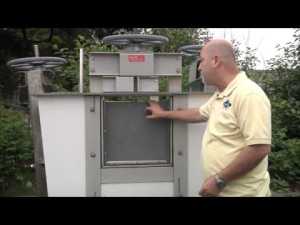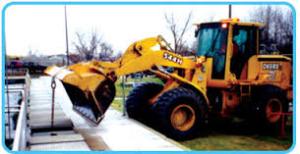Plasti-Fab flap gates act as a check valve by allowing flow to pass in one direction only. Any seating head will be held back, and unseating heads will pass. Like all Plasti-Fab products, Copolymer flap gates are corrosion resistant and long lasting. Key features include: Very low leakage rates, Rugged construction, Light weight when compared to cast iron or steel gates, Lower discharge head requirements, and Virtually no maintenance.
Plasti-Fab manufactures three distinct styles of flap gate.
Type I flap gates have a rigid door with a flexible neoprene hinge/seal arrangement. This is generally a Copolymer gate with a circular or rectangular body. Type I flap gates range in size from 4 inches to 36 inches.
Type II flap gates also have a rigid door, but use a stainless steel hinge mechanism to support the door. These gates will generally be used to close off larger openings and can be circular or rectangular. Double hinges are often required to help center and support the gate.
 Type III flap gate has a flexible cover or door, and is generally a larger tide or back flow control gate. This style of gate will most often be fabricated of stainless steel, will be square or rectangular, and can have a single or multiple covers. Type Ill gates are wall mounted and are available up to 8 feet square.
Type III flap gate has a flexible cover or door, and is generally a larger tide or back flow control gate. This style of gate will most often be fabricated of stainless steel, will be square or rectangular, and can have a single or multiple covers. Type Ill gates are wall mounted and are available up to 8 feet square.
GATE BODY: The Copolymer flap gate has a reinforced composite (FRP) body. Standard molds exist for all common pipe sizes from 4” through 60” diameter. Rectangular Copolymer gates range in size from 24” to 60”. Stainless steel gate bodies will be of T-304 or T-316 stainless steel as required by the application. These gates are typically square or rectangular and are available from 24” to 120”.
Depending on the style, size and application, flap gates will be bolted directly to a wall or bulkhead, flange mounted to a pipe, or clamped to the exposed end of a pipe.
COVER OR FLAP: The Type I hinge/seal assembly is a one piece cover that mounts directly to the gate body and will never need adjustment. It is perfectly aligned with the seating surface of the gate to produce a tight seal every time. Covers from 4” to 21” diameter are molded neoprene with an internal steel reinforcing disc. Larger diameter and rectangular covers are of molded neoprene and will have an FRP cover to provide the necessary structural support. Reinforcing belts or plys are vulcanized into the flap to prevent sagging.
The Type II gate cover uses a single or double stainless steel hinge, and is preferred by some engineers because of its more traditional look. The stainless steel hinge bolts directly to an FRP cover with a neoprene facing seal. Half inch diameter hinge pins with nylon sleeves permit the cover to rotate and seal tightly against the gate seat.
Type Ill flexible covers clamp directly to the gate body and frequently require additional support to maintain a flat seat. Generally steel reinforcing bars are molded into the neoprene flap, or external horizontal stiffeners are affixed to the cover. Sometimes vertical stainless steel support angles can be built into the clear opening of the gate body to provide the needed support.
 LOCATION: Flap gates are most commonly found at the end of a pipe line for back flow control, or to seal out pests and provide vector control. They are seen at many river out falls, in tidal and marshy areas, and around lakes or reservoirs with fluctuating water levels. Water and wastewater treatment plants are beginning to use more of these gates.
LOCATION: Flap gates are most commonly found at the end of a pipe line for back flow control, or to seal out pests and provide vector control. They are seen at many river out falls, in tidal and marshy areas, and around lakes or reservoirs with fluctuating water levels. Water and wastewater treatment plants are beginning to use more of these gates.
Copolymer & Stainless Steel Flap Gates
Type I Type II Type Ill
Gate Cover Rigid Rigid Flexible
Hinge Flexible hinge/seal Stainless Steel Flexible
Gate Body
Typical 4” to 36” 24” to 72” 36” to 96”
size range
Material Copolymer Copolymer & S/S Stainless Steel
Shape Round Round or Rectangular
Rectangular
Mounting Wall, Flange or Wall or Flange Wall mounted
Compression Ring
WHY BUY PLASTI-FAB?
- High corrosion resistance. Great for sea water and coastal areas or other harsh environments, especially when used with the neoprene seal/hinge.
- Excellent leakage performance.
- Light weight fiberglass.
- Low head loss.
- Little or no maintenance.











